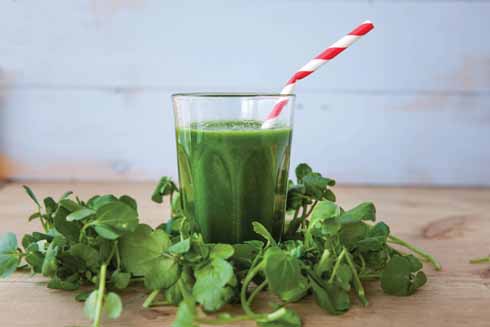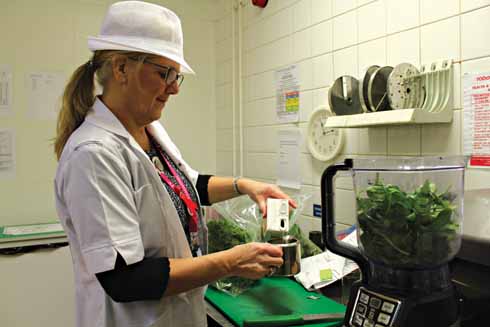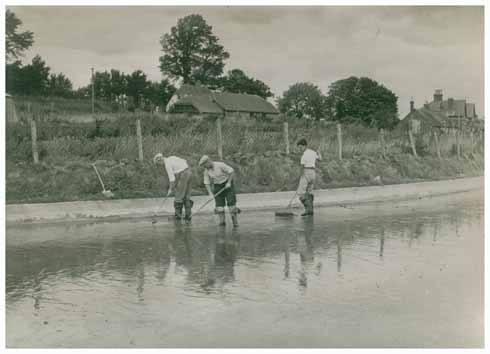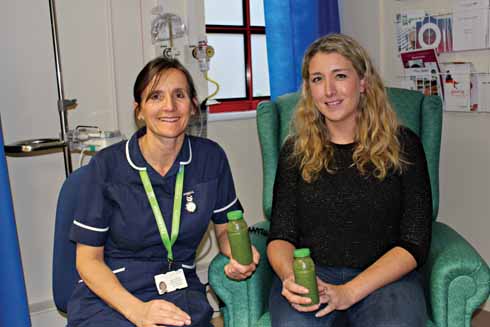Just what the doctor ordered
Claire Vera looks at the use of a special local produce at the County Hospital
Published in June ’17
It is late morning and lunch preparation in the kitchen at Dorset County Hospital is in full swing. Trays of veg are lined up and huge pots steam away. Despite the obvious workload and the feeling that there is a deadline to be met, this looks like a well-oiled machine. Catering Development Manager Jacqueline Garland is showing me the watercress smoothies being made at the hospital and given to cancer patients as part of a project run with the Watercress Company. ‘So far it has gone down very well,’ says Jacqueline. ‘We’ve encouraged staff to take part as well as patients on the Fortuneswell Ward, and the feedback has been very positive. The kitchen staff tried it, too. It’s an acquired taste, but the health benefits are so great.
‘We started with a watercress and spinach smoothie with ginger, apple and pineapple juice. That was quite spicy, it had a bit of a kick to it but a great flavour. Generally people have preferred a sweeter taste, so we’ve moved onto the smoothie with pineapple juice, spinach and mango together with the watercress and that has gone down well. We will be trying other flavours, too. We’re making thirty a day at the moment to go to the ward and the outpatient clinic, where the cancer patients have been trying the drink.’
‘It’s nice to do something different and innovative and to work with a local producer,’ says Lead Cancer Nurse Abigail Orchard. ‘When you’re diagnosed with cancer and you have to go through a number of treatments, you often feel you don’t have a lot of control about what’s going on. But their diet is the one thing patients can control and often ask about. It’s a great opportunity for them to try something different and to explore the nutritional benefits of watercress and other healthy foods.
‘Some find the colour offputting at first but lots of patients and relatives, carers and staff have been very positive about it. So I think it’s fair to say it has been a mixed response, primarily because watercress is quite a strong flavour. I actually really liked the original one, with ginger.
‘The project has involved the Dietetic Department here at Dorset County Hospital and I think it helps people to think about their diet a bit more, not just during treatment but afterwards as well. Cancer treatments have developed greatly over recent years – it means people are living longer and are also living longer with cancer. It is vital that patients address what they eat and the exercise they do and it’s up to us to try to help them to make the right choices to manage their health and well-being. We want patients to take control of what goes into their mouths.
‘I think we should explore everything, including the way that diet can complement traditional treatments. It’s not enough just to have a smoothie when you come in if you’re an outpatient, but we want people to continue with their healthy eating when they go home, so they’ve come up with some simple ideas for making the smoothies at home. It is really important in terms of hopefully reducing the risk of cancer returning, or new cancers even, as well as helping manage some of the side-effects of treatment. Obviously we can’t proclaim that it’s a cure, but it gives something to patients and helps them focus on their diet, which is important.
‘I have a smoothie every day now and I can honestly say that if there isn’t one available I feel disappointed.’
Heading up the project for the Watercress Company is trained chef Keri Astill. She is equally excited about the project at the hospital: ‘The first time I brought samples along, Abigail got all the other nurses to try it and there was a mixed response. Some didn’t like the colour. It is part of the challenge to get people to drink something they wouldn’t normally, but once you start having it regularly, you feel like you’ve missed out if you don’t get your daily smoothie.
‘The reaction at the hospital has been really good. It was quite daunting coming here but I knew that if I kept going it would work out. The main stumbling block has been that the catering department have tight budgets and are so busy. But we provide all the ingredients, the bottles and the blenders so they don’t have to take it from the budget and they’ve been great in providing some time to make them. They’re even hoping to make more smoothies and sell them in the canteen. The initial feedback told us that people want to change the recipe not to get bored with it, so that is something we’re doing. I can’t see any reason not to have it, just for the nutrients alone. I drink it every day because if there’s any chance it will improve my health and keep me well, I’m going to do it.

There’s a degree of mechanisation to modern watercress production, but the crystal-clear waters are still a requirement
‘We’ve funded studies into watercress and it’s about getting more research to prove that watercress can have an impact on cancer. There are a lot of aspects to watercress and health, but we wanted to focus on cancer. Everyone knows someone who has been affected by cancer, so I think it is a very important thing for us to try to do. This trial is working on the take-up: we’d need a large take-up for a full clinical trial. Once the initial trial is over and if it’s successful, we’ll consider other wards or other hospitals.

A gold-medal-winning display of Dorset watercress being shown off to the agriculture minister and Lord Mayor of Manchester, ninety years ago at the Imperial Fruit Show in Manchester
The Watercress Company, based in Dorchester, has 19 ha (47 acres) of watercress beds in Dorset and Hampshire as well as farms in Spain and Florida. The company supplies around 70% of the watercress sold in the UK with local sales outperforming national ones. James Harper is Commercial Manager: ‘Watercress has always been known as healthy. In ancient Greece Hippocrates, the father of modern medicine, sited his first hospital near wild watercress as it was known to be so good for the patients. Now with modern science we can see why. When you chew and digest watercress you break down plant cells and create a compound called isothiocyanate or ITC – that’s what gives it the peppery taste. So when you’re making a smoothie you’re smashing up these plant cells much better than when you chew it, increasing the peppery taste.’ Research has indeed shown that isothiocyanates are chemo-preventive agents and it is hoped that further research on humans could lead to their used in the treatment and prevention of certain cancers. Watercress also contains significant amounts of iron, calcium and vitamins A, C and E. ‘Gram for gram, you can’t get anything more nutrient-dense than watercress,’ says James. It’s got more vitamin C than oranges, more calcium than whole milk and higher levels of folate than banana. We call it the chairman of the chopping board – it’s packed full of everything you need.
‘There have been three or four studies on different types of cancer and on DNA damage. One was concerned with the free radicals caused by smoking. Also, when you do vigorous exercise – and I do a lot of long-distance running – you create DNA damage and watercress has been proven to repair that damage. So eating it before vigorous exercise can then help to repair the damage caused: you have all the benefits of exercise but none of the downside. It’s powerful stuff, it really is.
‘We’re lucky because Tom, our MD, has said that every staff member who wants one can have a free smoothie every day. So each day we have one on our desks made from spinach, watercress, banana, fruit juice and a bit of water. It’s delicious and it’s a really good start to the day.’
It will be interesting to see if clinical trials will result from this initial test study and whether treatments can be developed using isothiocyanates derived from the plant. From Hippocrates to modern science – in the future watercress could turn out to be just what the doctor orders.
|
Watercress Smoothie Recipes |
|||||
|
Orange and Strawberry |
Mango and Pineapple |
Apple and Ginger |
|||
| 33g 23g 65g 130g |
watercress spinach frozen strawberries orange juice |
33g 23g 65g 130g |
watercress spinach mango pineapple juice |
33g 23g 103g 65g 25g 1g |
watercress spinach water apple juice pineapple juice ginger |






